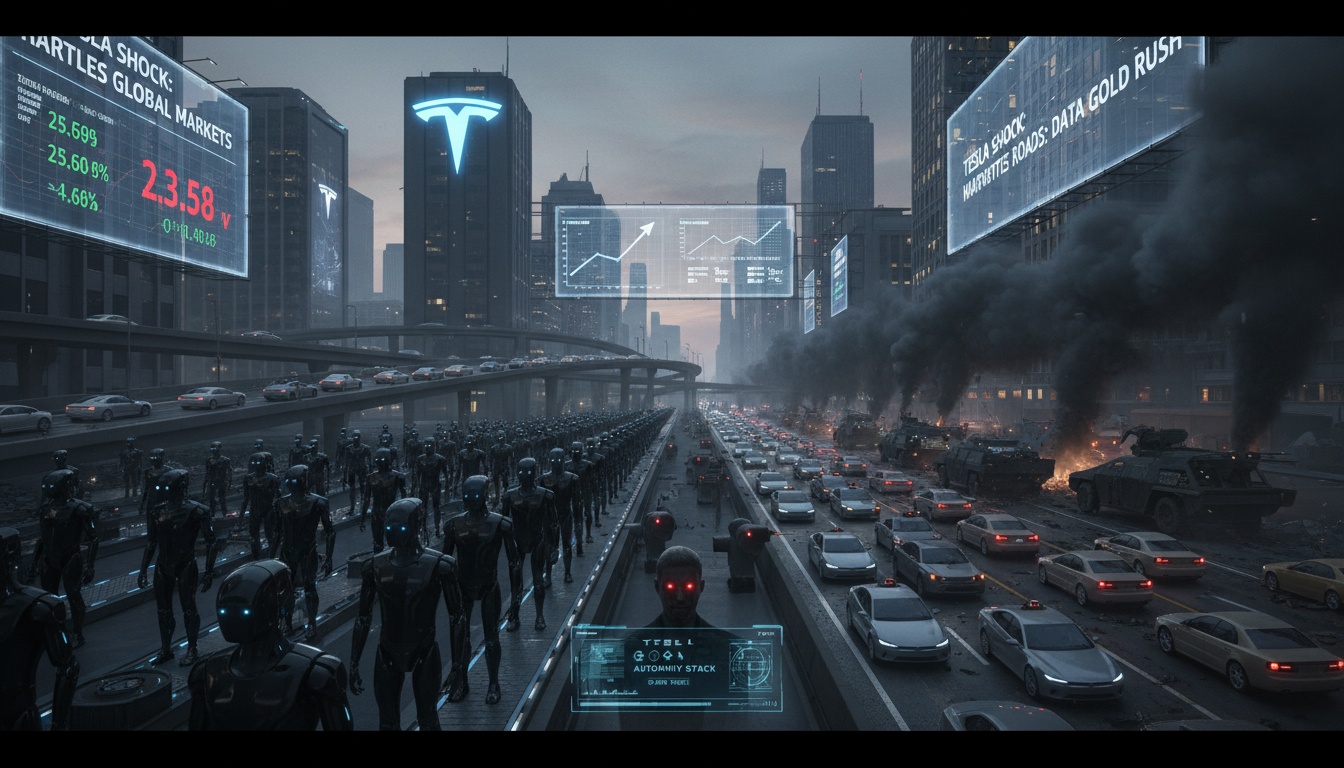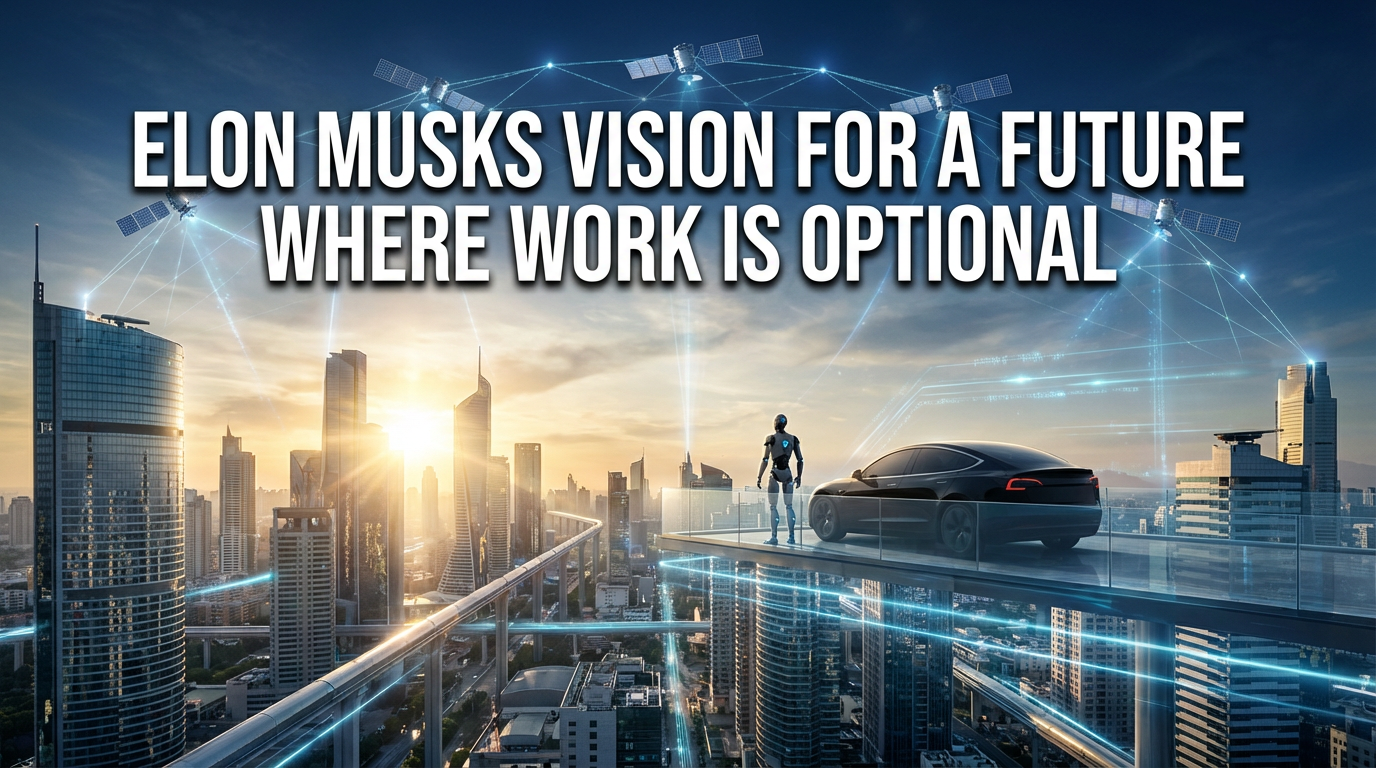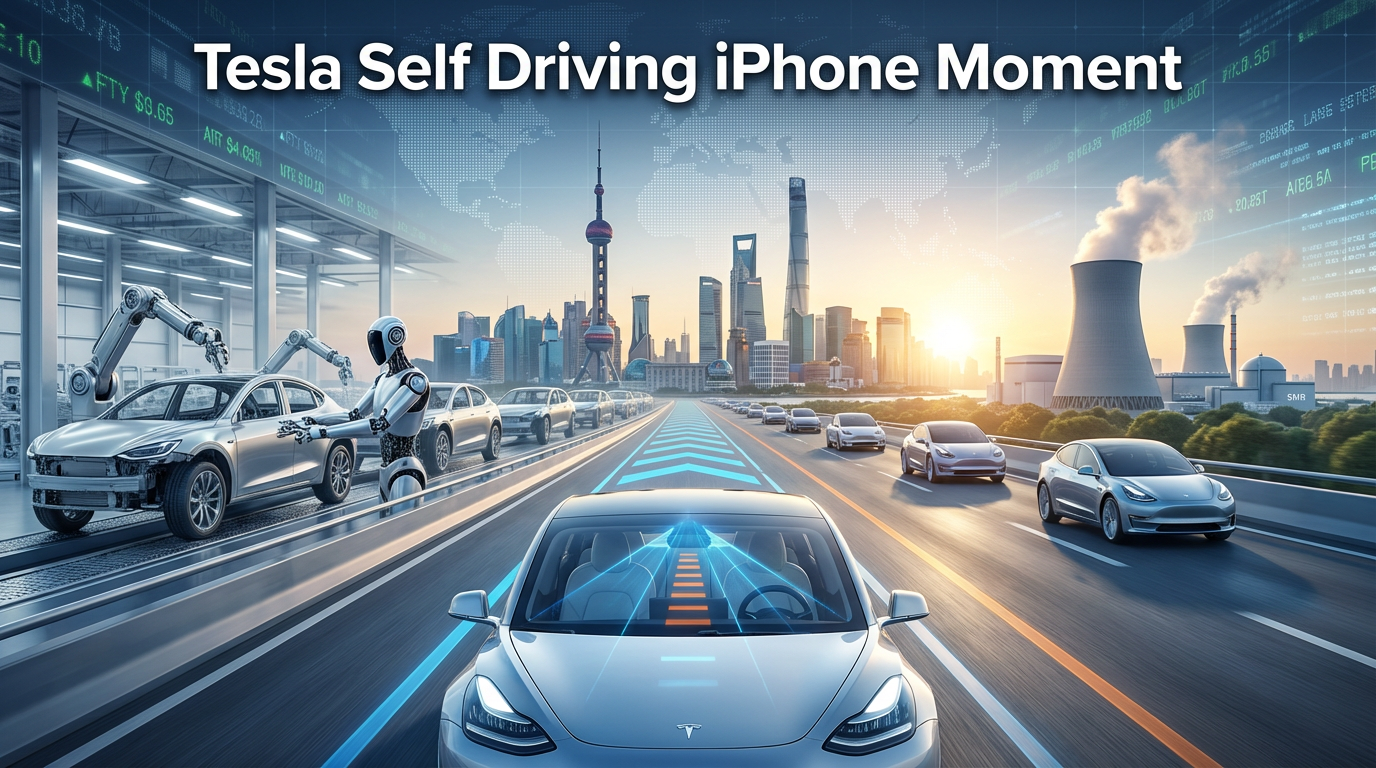● Tesla Price Shock – Budget Model 3 and Y, Vision FSD, Autopilot Axed
Tesla “Low-Cost Model 3·Y” Launched Outright, Revealing the Real Points Including FSD 14.1 and Optimus at Once
We have completely organized how Tesla cuts costs and makes up revenue with software behind the price shock.
We pick out only the key points that others rarely address, including the significance of FSD 14.1 switching to vision-based navigation, the regulatory, safety, and insurance impacts of removing basic Autopilot, the connection between robo-taxi, Optimus and the data flywheel, as well as demand elasticity and margin structure.
It also includes a checklist from an investment strategy perspective on why this price had to come now in the context of global economic outlook, interest rate, and inflation environment.
Summary of Key Checkpoints
Tesla has reset the price benchmark by launching the low-cost Model 3·Y with an MSRP in the $30,000 range.
FSD 14.1 has switched from relying on maps to vision-based navigation, enhancing destination selection and response to irregular environments such as parking lots.
Removing the basic Autopilot is a strategic move aimed at switching to FSD subscription and securing data, beyond just reducing hardware costs.
Optimus’ public exposure is interpreted as a signal for brand and data expansion through collaborations with xAI and entertainment.
In a high interest rate environment, the timing strategy works to reduce monthly payment burdens with a low MSRP and reignite demand in the EV industry.
Low-Cost Model 3·Y: Positioning More Than Specs Is Key
The Model 3 Standard RWD is revealed at approximately $36,990, and the Model Y Standard RWD at approximately $39,990.
Key hardware options have been organized and reconfigured to focus on essential performance and driving range.
Prices and specifications may vary by region and time, so it is necessary to check the actual purchase page.
Cost-Cutting Roadmap: What Was Removed and Why
Looking at the crucial deletion list and its meaning by function reveals the strategy.
- Driving Assistance: Basic Autopilot (lane keeping) is removed, downgraded to a simple cruise focus. This creates a “blank slot” for paid software upselling.
- Chassis/Comfort: Switching from electronic dampers to passive ones reduces BOM, complexity, and A/S risks.
- Interior: Fabric seats, reduced number of speakers, and the deletion of ambient lighting and second-row displays are parts that significantly cut costs while minimally affecting the perceived value.
- Radio/Glass Roof Processing: Simplifying options and finishes reduces production variability.
- Additional features related to core driving such as camera cleaning are minimal enhancements for safety and FSD performance.
The core is a configuration that “preserves the essence of the driving experience and safety, while boldly eliminating additional convenience and emotional elements.”
FSD 14.1: A Game-Changer From “Maps → Vision”
Summarizing user reports and public demonstrations, the following changes are key points.
- Vision Navigation: It reduces map dependency and immediately creates detour routes by understanding road structure and vehicle flow through cameras.
- Arrival Options: It remembers and reflects precise arrival positions for each destination such as home, office, or roadside.
- Irregular Environment Response: It shows more natural operation even in enclosed spaces like parking lot ramps, exit sign estimation, and gate waiting.
- Driving Style Selection: It enhances ride comfort and safety margin through situational style changes, such as a more cautious “sloth” style.
- Enhanced recognition of emergency vehicles and small obstacles, and maintaining visibility with automatic camera cleaning.
Due to legal and technical limitations, driver supervision is still required, and some features are known to be optimized for vehicles with HW4 and above.
The real significance of this transition is that it takes a step toward a “world model that works without maps,” which is essential for robo-taxis.
Optimus·Entertainment Collaboration: Simultaneous Expansion of Data and Brand
A public stage appearance like a movie premiere is not merely promotion but an opportunity to accumulate real-world interaction data and safe performance protocols.
The collaboration between xAI, Tesla, and content companies is advantageous for spreading public awareness of the “AI trend,” recruiting, and expanding the partner ecosystem.
The universe linking vehicles, robots, and content positions Tesla as a universal AI/robotics platform beyond the electric vehicle industry.
Demand and Price Elasticity: Why the $30,000 Range Now
In a high interest rate phase, sensitivity to monthly payments increases, and a low MSRP significantly lowers the tangible purchase barrier.
In a conservative expenditure phase for durable goods due to inflation, a “price with only the essentials” is the most effective card to broaden the demand base.
In terms of competition, it defends by forming a price front with Chinese low-cost EVs, the spread of NACS adoption by other OEMs, and maintaining a branding and charging infrastructure edge amid subsidy volatility.
Even in a global economic outlook marked by growth deceleration and a defensive economy phase, the “low-cost + software upsell” model is effective as a total revenue maximization strategy.
Regulation, Safety, and Insurance: Ripple Effects of Removing Basic Autopilot
In some regions, lane-keeping assistance indirectly influences safety ratings, which may lead to differentiated configurations by market and country.
Insurance premiums can change depending on whether ADAS is applied, so it is essential to compare estimates before delivery.
The structure that allows for expansion of functions via OTA enables swift responses to future regulatory changes.
The core is a design that “absorbs regulatory risks with software.”
Battery and Supply Chain Perspective: Optimized Choices for a Low-Cost Model
The rear-wheel drive configured for a balance between driving range and output is advantageous for optimizing the usage of motors, inverters, and batteries.
An LFP-centric combination (which may vary by region) is well-suited for entry-level models in terms of cost, lifespan, and charging patterns.
Reducing the number of parts and standardizing components lowers production turnaround time, failure rates, and inventory risks.
Revenue Model Restructuring: Hardware Margin vs. Software Gross Profit
While hardware margins may be lower in the short term, in the long run the high gross profit margin of the software segment will boost the overall company margin.
Here is an example scenario:
- A scenario with low-to-mid hardware margins, with additional revenue contributions from FSD, enhanced Autopilot, and connectivity subscriptions.
- As FSD subscription conversion increases, the cumulative LTV surges, and software revenue can continue even when transitioning to used cars.
- When robo-taxi commercialization occurs, fleet operation revenue and data value will overlap.
The core is “maximizing mobility MAU with a low-cost approach and monetizing with AI services.”
Robo-Taxi and Data Flywheel: A Virtuous Cycle from Vehicle → FSD → Optimus
Expanding low-cost sales increases the reservoir capacity of driving data and speeds up the learning of the vision network.
FSD 14.x’s “arrival options” and navigation for irregular environments are prerequisites for automating pickup and drop-off.
Optimus requires data from a mixed indoor-outdoor environment, making it complementary to the world model created by vehicles.
The conclusion is the overarching design that “hardware is the sensor, software is the brain, and data is the oxygen.”
7 Investment Strategy Watch Points
- Demand Rebound: Check how much the $30,000 range lowers monthly payments at current interest rates and the speed of absorbing pent-up demand.
- Margin Mix: The balance between an expanding share of low-cost models and growth in the software subscription segment.
- FSD Performance Curve: The trend toward improved stability in irregular environments from the rollout of 14.1→14.2/14.3.
- Regulatory Path: Changes in regional ADAS regulations, insurance data, and safety ratings.
- Supply Chain: Battery procurement and assembly capacity, and the impact of simplified trims.
- Robo-Taxi Roadmap: The actual beta rollout of pickup/drop-off automation and partnerships.
- Brand/Ecosystem: The impact of xAI and content collaborations on recruiting and the developer ecosystem.
Consumer Guide: Which Trim Is Right for You
- For commuters, urban driving, and cost priorities: The Standard RWD is sufficient, with necessary features available later as software options.
- For long-distance, highway driving, and preference for enhanced options: Decide in advance on the inclusion of Long Range or higher, along with Autopilot and adaptive options.
- Considering insurance and resale value: Comparing estimates is essential since the application of ADAS can affect insurance premiums and resale value.
- Charging environment: Maximize the utility of the Standard model if you have home charging, or check efficiency and charging speed if relying mainly on public charging.
- Test: It is important to personally test ride to check the ride comfort, noise, seat material, and other tangible factors.
Risks and Opportunities: A Quick Overview
- Risks: Consumer backlash over the removal of basic driving assistance, regulatory compliance in some regions, and short-term margin pressure.
- Opportunities: Securing leads due to price elasticity, increased FSD subscription rates, accelerated data network effects, and progress in robo-taxi preparation.
- Overall: The strategy of “opening the door with price and locking it with software” has become fully underway.
< Summary >Tesla has begun to expand its demand base with the Model 3·Y in the $30,000 range and has started fitting the key puzzle for robo-taxis with FSD 14.1’s vision-based navigation.
Removing the basic Autopilot is a winning move aimed more at FSD upselling and securing data than at cost reduction.
In an environment of high interest rates and inflation, the low MSRP reduces the tangible purchase barrier while the structure elevates long-term profitability through software gross profits.
The Optimus·xAI collaboration signals simultaneous expansion of brand and data.
Consumers should select trims based on usage patterns, insurance, and charging environment, while investors should focus on demand rebound, the FSD performance curve, and the software revenue mix.
[Related Articles…]The Economics of Tesla’s Low-Cost Strategy
Examining the Timeline for Robo-Taxi Commercialization
Additional Reference
- This article is an analysis based on publicly available announcements and user reports, and specifications, prices, and software support may vary by region and time.
- Investment decisions are each individual’s responsibility, and this article is not investment advice.
- SEO keyword reference: global economic outlook, interest rates, inflation, investment strategy, electric vehicle industry.
*Source: [ 오늘의 테슬라 뉴스 ]
– 테슬라 ‘저가형 모델 3·Y’ 전격 출시! $36,990 실화? FSD 14.1·옵티머스까지 동시 공개!
● Humanoid Arms Race, 4Q-2025 Investment Playbook
Is This the Era of Roboticism?: The Prelude to the Humanoid War, A Comprehensive Summary of Key Investment Checkpoints for 4Q & 2025
This article contains a genuine investment perspective that is rarely discussed on other YouTube channels or in the news.It explains when and with which cost structure humanoid robots will begin to generate revenue.It covers hourly costs that incorporate depreciation, damage, and insurance, as well as the human replacement threshold.It reviews supply bottlenecks in key components (reducer, actuator, battery, vision) and a “pick-and-shovel” investment map.It details how the semiconductor cycle is reshaped by the transition to edge AI chips.It describes how safety, regulation, and standards determine the timing of revenue recognition.It also encompasses a macro scenario that combines interest rates, exchange rates, power, wages, and policies.Just grab what you need quickly from below.
1) Reasons to Read Now: The Core Structure of This Article
- The impact of the 4Q 2024~2025 global economic outlook and interest rate path on robot CAPEX.
- The humanoid technology stack (hardware, software, data) roadmap and commercialization thresholds.
- Methods for calculating unit cost, RaaS (robot-as-a-service) hourly fees, and ROI (return on investment).
- Bottlenecks in the supply chain and “pick-and-shovel” investments: reducers, motors, sensors, edge AI, simulation.
- The risk/opportunity interface created by regulation, safety, and standards, along with company-specific checklists.
- The trading playbook for 4Q and a mid-to-long-term positioning strategy for 2025.
2) Macro Environment: The Robot Demand Curve Shaped by Interest Rates, Wages, Power, and Exchange Rates
- Interest Rates: The longer the period of high interest rates, the higher the required internal rate of return for labor-substitution CAPEX.
- Therefore, it will be adopted first in “clear single tasks” with an ROI within two years (picking, packing, palletizing, machine tending).
- Wages/Population: Rising hourly labor costs and high turnover in logistics and manufacturing sites serve as the primary investment rationale for humanoids.
- Countries with strict constraints on population structure and immigration policies will adopt them more quickly.
- Power/Power Prices: Assuming a robot uptime of over 80%, battery replacement, charging infrastructure, and peak rate management are key.
- Exchange Rates: A weak Korean won squeezes the margins of domestic manufacturers initially, given their high reliance on imported parts.
- Policies: Reshoring, safety regulations, and subsidies in various countries determine the speed of transition from pilot projects to mass production.
3) Technology Stack Roadmap: Hardware, Software, and Data Engine
- Hardware
- Actuators/Reducers: The price is determined by high-torque density motors and harmonic reducers.
- Arms/Hands/Grippers: Task-specific end-effectors will generate revenue before generic hands.
- Sensors: An RGBD, ToF, force/torque, and IMU combination is fundamental, while event cameras are advantageous for fast, delicate tasks.
- Batteries: Focusing on LFP for safety and cycle life, with operations likely to be a mix of swap and wireless.
- Software
- Motion/balance control generally relies on a combination of ROS 2 and real-time fieldbuses (EtherCAT).
- Domain rendering based on simulation (Isaac Sim, Unity) lowers data costs.
- The safety layer uses edge-based end control to ensure latency guarantees, while the cloud handles fleet management.
- Data Engine
- Initial datasets are built through a mix of teleoperation and autonomy, and generalized via off-policy learning.
- Robot foundation models (GR00T, RT series, etc.) and vision-language models create task composition and instruction comprehension.
- After field deployment, the loop “data → update → re-simulation → OTA” is the essence of competitiveness.
4) Unit Cost and Revenue Model: The Critical Thresholds for Profitable Revenue
- Manufacturing Cost (CoGS)
- The initial full-stack humanoid CoGS is commonly in the range of $80,000 to $150,000.
- Success depends on the pace of price reduction and yield improvements in reducers, motors, batteries, and computing.
- Service-Based Billing (RaaS)
- An hourly band of $8 to $25 at the site is the first threshold for human replacement.
- The total cost of ownership (TCO) must always include maintenance, consumables, insurance, and charging/swapping infrastructure.
- Return on Investment (ROI)
- Based on a shift system with 4,000~5,000 hours of annual operation and accounting for absentee/turnover risks, an ROI of 18~24 months is the actual decision-making cutoff.
- Once uptime reaches 99.5% and MTBF exceeds 1,000 hours, scaling up accelerates significantly.
5) Supply Chain & Pick-and-Shovel Investment: Identifying the Actual Bottlenecks
- Reducers/Precision Gears: The supply of harmonic and cycloidal types is tight.
- Motors/Drives: High-torque, high-efficiency BLDC motors and safety-rated drives command a premium.
- Sensors: Demand for industrial vision, 3D depth, force/torque sensors, and safety LiDAR will rise first.
- Edge AI Semiconductors: Demand is shifting from training data centers to on-robot edge inference.
- Simulation/Digital Twin: Subscription models, rather than per-unit sales, provide higher economic defensibility.
- Communication/Field Networks: TSN and private 5G determine the reliability of large-scale fleets.
6) Company Map and Checklist: Who is Verifying What
- Global Player Snapshot
- Humanoid/Full-Body: Tesla (Optimus), Agility (Digit), Figure, 1X, Apptronik, Sanctuary, Unitree, Fourier, UBTech, etc.
- Industrial Ecosystem: Siemens, Rockwell, Keyence, Cognex, Zebra, SICK, IFM, Fanuc, ABB, Yaskawa.
- Semiconductors/Platforms: NVIDIA (Isaac, Jetson Orin/Thor), ARM, Qualcomm, AMD.
- Checklist
- The conversion rate from pilot to paid deployment and uptime per unit.
- The speed of expansion to second/third sites with the same customer.
- The stage of safety certification (ISO 10218, 13482, etc.) and trends in insurance premiums.
- The cycle of software updates and the consistency of release notes.
- The degree of vertical integration in components and the roadmap for internalizing reducers and batteries.
7) Regulation, Safety, and Standards: The Invisible Switch for Revenue Recognition
- Regulation is not a risk but a gateway to commercialization.
- As co-bot regulations and humanoid safety standards become clearer, the approval speed from PoC to mass production increases.
- Liability/Insurance: The mix of autonomous/teleoperation, separation of dangerous areas, and black box logging is key to determining insurance premiums.
- Data/Privacy: The handling and retention period of vision logs as personal data have emerged as essential items in RFPs.
8) Use Case Prioritization: Based on ‘Profit’ Instead of ‘Possibility’
- Priority 1: Picking/packing/rework in logistics centers, palletizing, cart transportation, dock unloading.
- Priority 2: Machine tending in manufacturing sites, simple assembly/loading, quality inspection.
- Priority 3: Retail replenishment, security/patrol, facility inspection, in-hospital logistics.
- The point is to start with processes that have high uptime and repetition, while postponing multi-variety tasks until sufficient simulation data is accumulated.
9) Semiconductor Cycle Restructuring: Shifting the Focus from Training to Edge Inference
- As robot deployment accelerates, the demand for ‘AI inference on the edge’ will skyrocket.
- This will drive high-performance, low-power edge chips and enhancements in on-board memory, in addition to the existing GPU cycles centered in data centers.
- The increase in cameras and sensors along with real-time multimodal processing will standardize the inclusion of NPUs/DLAs.
- The semiconductor ecosystem will expand simultaneously along two axes: “high bandwidth for training” and “ultra-low latency for edge.”
10) Investment Strategy: 4Q Playbook and 2025 Positioning
- 4Q Tactics
- Volatility will increase around major events and pilot announcements.
- Instead of news trades, aim for defensive plus alpha through supply chain “pick-and-shovels” (reducers, vision, edge AI, simulation).
- 2025 Strategy
- Focus on companies with rising paid conversion rates from initial commercial deployments as the core, while satellite investments target edge inference semiconductors and industrial vision.
- In the RaaS accounting structure, signals of ARR (annual recurring revenue) expansion receive a premium.
- If interest rates ease, unit sale models can be re-rated due to client CAPEX resumption.
11) Risks and Alternative Scenarios
- Technological Risk: A high failure rate in hand/delicate tasks could undermine uptime assumptions.
- Regulatory Delays: If safety certifications lag, revenue recognition will be postponed.
- Supply Chain: Bottlenecks in reducers and batteries could limit yield.
- Alternative: Generate revenue first with single-task (hand + vision specialized) units, then expand versatility through modular replacement.
12) Field Checklist You Can Use Immediately
- Hourly TCO vs. on-site labor costs (if replacement rate exceeds 70%, pilot GO).
- Target uptime of 99.5%, MTTR within 30 minutes, and adequate backup unit rotation.
- Pre-agree on safety area separation, emergency stop, and black box log policies.
- Clearly state the data pipeline (collection → anonymization → learning → deployment) in the contract.
- Operate a weekly update rhythm with simulation-to-field gap KPIs.
13) Conclusion: ‘When’ and ‘Where’ Are Decisive
- Humanoids are transitioning from a stage of mere possibility to one of economic viability.
- The moment when interest rates, wages, power, and regulations come together, the S-curve will rapidly launch starting with single tasks.
- Investors should build their core around players that demonstrate confirmed paid conversion rates, based on pick-and-shovel investments and edge AI semiconductors.
- While 4Q is the time to build positions, 2025 is likely to be the inaugural year where field references translate into revenue.
< Summary >
- Interest rates, wages, and power determine the ROI threshold, and adoption will explode starting with single tasks.
- The bottlenecks are reducers, actuators, vision, and edge AI, with pick-and-shovel investments serving as the defensive and growth point.
- RaaS hourly rates of $8 to $25 and an ROI of 18 to 24 months are the actual purchasing benchmarks.
- Regulation and safety certification determine the timing of revenue recognition.
- 4Q is for exploiting volatility, and 2025 is for concentrated investments in paid conversion rates and edge semiconductors.
[Related Articles…]
- 10 Investment Points for Humanoid Robots
- The Connection Between AI Robots and the Semiconductor Supercycle
Keywords: Global Economic Outlook, Interest Rates, Artificial Intelligence, Robots, Semiconductors
*Source: [ 소수몽키 ]
– 지금부터는 로봇주의 시대? 휴머노이드 로봇 전쟁의 서막



